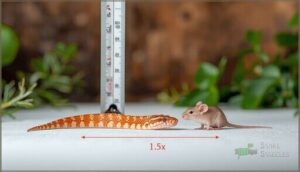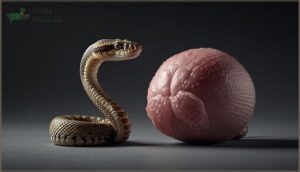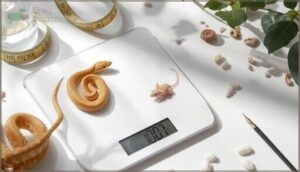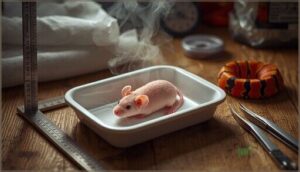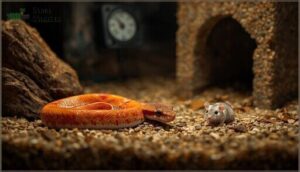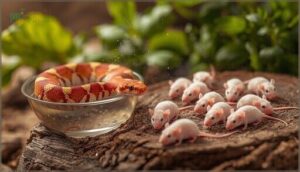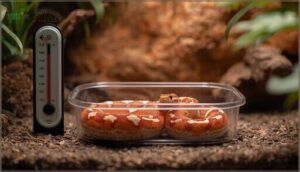This site is supported by our readers. We may earn a commission, at no cost to you, if you purchase through links.
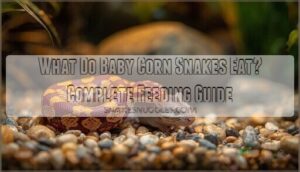
Getting their diet right means understanding not just what they eat, but how much, how often, and what size prey keeps them thriving without causing digestion problems. The difference between a healthy, growing snake and one that refuses food or regurgitates often comes down to matching their natural feeding patterns with the realities of captive care.
This guide breaks down everything from selecting appropriately sized pinkie mice to adjusting your feeding schedule as your snake matures.
Table Of Contents
- Key Takeaways
- What Do Baby Corn Snakes Eat?
- How Often to Feed Baby Corn Snakes
- Choosing The Right Prey Size
- Preparing and Offering Food Safely
- Handling Feeding Challenges
- Essential Nutrition and Supplements
- Creating an Ideal Feeding Environment
- Frequently Asked Questions (FAQs)
- What can you feed baby corn snakes?
- How do you take care of a baby corn snake?
- What can I feed my corn snake if I don’t have mice?
- Should I feed my baby corn snake 2 pinkies?
- How do baby corn snakes hunt in the wild?
- Can baby corn snakes recognize their owners?
- What are signs of a hungry baby snake?
- How does light exposure affect feeding habits?
- Are there specific times to feed hatchlings?
- Can baby corn snakes eat fish or amphibians?
- Conclusion
Key Takeaways
- Baby corn snakes are obligate carnivores that require whole prey—primarily pinkie mice weighing 2-3 grams—fed every 5-7 days, with prey diameter never exceeding 1.5 times the snake’s thickest body point to prevent regurgitation and impaction.
- Frozen prey is the safest choice for captive feeding, eliminating the 12% parasite risk from wild-caught options and preventing injury from live rodents, while proper thawing to 95-100°F ensures digestion success.
- Environmental conditions directly impact feeding behavior—snakes need thermal gradients between 75-92°F, 40-60% humidity, and a 48-hour handling pause after meals to avoid the regurgitation complications that affect 58% of hatchling health incidents.
- While wild hatchlings consume insects, amphibians, and small lizards opportunistically, captive snakes thrive on rodent-exclusive diets that provide superior calcium ratios and eliminate nutritional gaps, with feeding frequency adjusting to every 7-12 days as juveniles mature.
What Do Baby Corn Snakes Eat?
Baby corn snakes need a diet that mirrors what they’d eat in the wild, but with safer, more controlled options. Their meals should be appropriately sized and nutritionally complete to support healthy growth during these critical early months.
Let’s look at the main food sources that will keep your young snake thriving.
Pinkie Mice as Primary Food
For most baby corn snakes, pinky mice form the foundation of a healthy diet. These 1–2.5-gram rodents offer around 64% protein and 17% fat, but their low calcium content means you’ll eventually need to switch to larger prey.
You should feed one pinky every five days, thawing it safely before offering. Purchasing them in bulk with frozen pinkie mice subscription options can be convenient.
Proper prey size and feeding frequency prevent nutritional gaps as your snake grows.
Suitable Insects and Worms
While wild hatchlings consume earthworms, crickets, and grasshoppers in up to 15% of their diet, captive baby corn snake food routines rarely include insects. Only 2% of breeders report captive feeding success with these alternative protein links.
Insect calcium ratios like cricket’s 1:9 fall far below rodent standards, and worm digestibility rates reach just 75–85%. Most experts recommend avoiding insects as primary baby corn snake diet components due to nutritional gaps.
Hatchling corn snakes benefit from frequent meals, so they should be fed every 5-7 days.
Occasional Frogs, Tadpoles, and Lizards
Frogs, tadpoles, and lizards appear in wild baby corn snake diets at rates up to 45% during early life, especially near water sources after rainfall. These amphibian and reptile prey offer 12–16% protein content with over 84% digestibility, supporting faster juvenile growth rates.
However, wild-caught specimens carry parasite risks, including a 12% infection rate documented in studies. Captive baby corn snake food routines usually exclude these items due to safety concerns and nutritional consistency with rodent-based feeding.
How Often to Feed Baby Corn Snakes
Feeding your baby corn snake on the right schedule is one of the most important things you can do for its health and growth. Hatchlings have different nutritional needs than adults, so you’ll need to adjust how often you offer food as your snake matures.
Let’s look at the feeding frequency that works best, how to modify it over time, and the signs that tell you when your snake is truly hungry.
Recommended Feeding Frequency
You’ll want to feed your hatchlings every 5-7 days for ideal growth and digestive health. This feeding frequency promotes steady development without overwhelming their metabolism. Here’s what proper feeding intervals provide:
- Consistent growth without rapid fat accumulation or nutritional gaps
- Complete digestion between meals, as metabolic rates return to baseline in 3-5 days
- Healthy weight curves when you monitor monthly and adjust as needed
- Prevention of regurgitation that occurs with overly frequent feeding
- Strong development compared to extended intervals beyond 10 days
Adjusting Schedule as Snake Grows
As your hatchling matures into a juvenile, you’ll need to adjust both prey size and feeding intervals to match its changing metabolism. Juveniles between 20-45 inches require fuzzy or small mice every 7-10 days, while subadults move to 10-12 day feeding schedules.
Weight monitoring every month ensures your feeding frequency fosters healthy growth without promoting obesity. Seasonal adjustments may further fine-tune your snake’s nutritional needs.
Recognizing Signs of Hunger
Your baby corn snakes reveal their appetite through distinct behavioral shifts. Tongue flicking intensifies as they detect chemical cues, while activity increases throughout the enclosure signals readiness for pinky mice.
Watch for heightened movement interest when you approach, along with escape attempts against glass or lid. Some hungry juveniles develop a temporary strike response during handling, making a consistent feeding schedule essential for managing their appetite safely.
Choosing The Right Prey Size
Getting the prey size right isn’t just about feeding your snake—it’s about keeping them safe. A meal that’s too large can cause regurgitation, impaction, or even injury during swallowing.
Let’s break down how to match prey to your baby corn snake’s size and what guidelines you should follow.
Matching Prey Size to Snake Size
Sizing prey for your baby corn snake isn’t guesswork—it’s about matching dimensions. The prey width ratio is straightforward: choose prey no wider than 1.5 times your snake’s thickest point.
For hatchlings eating pinky mice, follow the weight percentage rule of roughly 10% of body weight. If needed, offer multiple small prey items to meet this target while supporting healthy growth rate mirroring.
Dangers of Oversized Prey
Oversized prey isn’t just hard to swallow—it’s dangerous. When you feed your baby corn snake prey exceeding 1.5 times its girth, you’re inviting serious consequences of improper feeding.
Feeding baby corn snakes prey larger than 1.5 times their girth invites regurgitation, impaction, and serious injury
Regurgitation risks climb to 19% in juveniles, while impaction issues affect 15% of young snakes. Injury prevention matters: jaw injuries occur in 7% of cases involving oversized pinky mice.
Stress reduction and proper prey size directly impact your snake feeding success and long-term health.
Prey Weight Guidelines
Getting the weight ratio right is like finding the perfect fit—too much overwhelms your snake’s system. You’ll want to follow these specific prey weight guidelines for safe feeding:
- Keep prey weight under 10% of your baby corn snake’s body weight per meal
- For hatchlings weighing 18-25 grams, offer 2-3 gram pinky mice
- Limit prey diameter to 1.5 times your snake’s mid-body width
- Switch to fuzzies when your snake reaches 25-30 grams
- Monitor growth monitoring weekly to adjust feeder types and prevent overfeeding risks
Preparing and Offering Food Safely
Proper food preparation can make the difference between a healthy meal and a dangerous situation for your baby corn snake. The way you thaw, warm, and present prey affects both your snake’s safety and its willingness to eat.
Let’s cover the essential steps you need to follow every feeding time.
Thawing and Warming Frozen Prey
Frozen prey for your baby corn snake needs careful thawing to avoid digestive distress. The safest method is placing a pinky mouse in a sealed bag, then submerging it in warm water for 10–30 minutes until the center is soft. Check for spoilage signs before feeding—unusual odor or appearance means discard immediately. Never refreeze thawed prey, as bacterial growth accelerates rapidly.
| Thawing Method | Duration & Temperature |
|---|---|
| Refrigerator | 2 hours at 35–40°F |
| Warm water bath | 10–30 minutes (sealed bag) |
| Room temperature | Several hours (check center) |
| Avoid microwaving | Uneven thawing risks regurgitation |
| Target prey temp | 95–100°F before feeding |
Using Tongs or Tweezers
Once your prey is properly warmed, handling it with tongs or tweezers becomes your next smart move. This simple tool choice slashes bite risk by up to 80%, since your hand stays well outside striking range when feeding baby corn snakes with frozen pinky mice. Long tongs also help with hygiene control, preventing cross-contamination between you and your pet.
- Stimulating feeding responses: Gentle wiggling mimics live prey movement, triggering natural strike behavior in reluctant eaters
- Tool choice matters: Opt for 10–12 inch stainless steel tweezers with soft tips to protect your snake’s mouth during delivery
- Training benefits add up: Consistent tong use teaches your snake to associate the tool—not your fingers—with mealtime, reducing food-response bites by roughly 60% within three weeks
Target training with brightly colored tongs reinforces this conditioning, making future handling and enclosure cleaning safer as your snake matures.
Avoiding Live Prey
While tongs keep you safe, the prey itself poses its own risks. Live pinky mice can scratch hatchling corn snakes, and as rodents mature, injury risks jump sharply—bites can damage eyes or even trigger bacterial infections needing antibiotics.
Frozen prey eliminates these handling dangers entirely, which is why over 95% of keepers now skip live feeding. Disease transmission drops, welfare concerns vanish, and your baby snake stays healthier.
Handling Feeding Challenges
Even the healthiest baby corn snakes sometimes refuse food, and understanding why this happens will help you respond appropriately. Several common factors can disrupt your snake’s feeding routine, from environmental stress to natural biological cycles.
Let’s look at the main challenges you might encounter and how to address them effectively.
Encouraging Reluctant Eaters
When your baby corn snake refuses meals, scenting techniques can transform meal refusal into a feeding response. Hatchlings often accept prey presentation enhanced with lizard or frog odor, boosting success rates up to 80%.
You can also try alternative prey like chick portions, adjust feeding time to evening hours, or wiggle the prey with tongs to mimic natural movement.
If three consecutive meals are refused, vet intervention becomes necessary to address factors affecting snake appetite.
Stress and Appetite Loss
Sometimes meal refusal stems from deeper issues than simple pickiness. Stress ranks among the leading anorexia causes in captive juveniles, with up to 40% experiencing temporary appetite loss after relocation.
Watch for these stress indicators:
- Hiding for 70% or more of daylight hours
- Reduced exploration and lethargy before refusing food
- Defensive strikes or hissing during feeding attempts
- Changed basking patterns signaling environmental disruption
- Persistent refusal lasting beyond two weeks
Husbandry adjustments—optimizing temperature, humidity, and hiding spots—resolve 80% of cases within 7-10 days. Handling impact matters too; delaying interaction for one week after arrival cuts meal refusal rates by half. If appetite loss exceeds 30 days or weight drops 15%, veterinary intervention becomes necessary to rule out illness.
Food Refusal During Shedding
During the shed cycle, your baby corn snake will likely skip meals—73% of juveniles refuse food while shedding compared to 56% of adults. This shedding appetite loss is normal, driven by impaired vision during the “blue phase” and hormonal shifts.
Most resume eating within 24 hours post-shed. Maintaining 65-75% humidity reduces complications, helping your snake return to regular feeding patterns faster.
Essential Nutrition and Supplements
Feeding your baby corn snake the right prey is just the beginning—understanding what’s inside that prey and how it fuels growth is equally important. While whole prey items like pinkie mice provide most of the nutrition your snake needs, you should also pay attention to vitamins, minerals, and hydration to support healthy development.
Let’s break down the key nutritional elements that keep your baby corn snake thriving.
Nutritional Requirements for Growth
Your hatchling’s growth depends on more than just frequency—nutritional quality matters. Pinky mouse prey should deliver 18–20% crude protein and roughly 55–60 kcal per 100 grams to fuel rapid development.
Temperature impact is real: proper warmth aids digestion, while dehydration needs attention through fresh water access.
Feeding frequency and prey size directly shape caloric density intake, ensuring your snake gains 19–29 grams by eleven months.
Vitamin and Mineral Considerations
Despite rodent-based diets, nutrient deficiencies can sneak in. You’ll want to address calcium ratios—aim for that 1.6:1 calcium-to-phosphorus balance—by lightly dusting prey with a 50/50 calcium and multivitamin mix every other feeding.
Without UVB lighting, D3 supplementation becomes critical for bone health.
Watch for hypervitaminosis risk with vitamin A; the supplement market offers plenty, but overdosing fat-soluble vitamins poses real danger if you’re not tracking doses carefully.
Hydration and Water Quality
Water dish size matters—think full-body submersion for your hatchling. Tap water safety is generally fine, though many keepers use conditioners to remove chlorine. Replace water daily since baby corn snakes often defecate in their bowls.
Dehydration signs include wrinkled skin and sunken eyes; catch them early with electrolyte solutions and proper humidity control between 65–75%. Consistent access prevents shedding troubles in snake care.
Creating an Ideal Feeding Environment
Your baby corn snake won’t eat properly if the environment isn’t right. Temperature, stress levels, and how you handle your snake all play a role in successful feeding. Let’s look at the three key factors that create the ideal feeding setup.
Temperature and Humidity Needs
Think of your baby corn snake’s enclosure as a miniaturally controlled climate zone—temperature regulation and humidity control directly impact digestion and growth. Your heating setup must provide a thermal gradient between 75–82°F at the cool end and 88–92°F in the basking area, with night temperatures staying above 75°F.
For hatchlings, maintain these essentials:
- Monitor tank temperature using digital probe thermometers at both zones
- Keep humidity between 40–60%, increasing to 70% during shedding
- Use humidity monitoring tools to prevent shedding issues and respiratory problems
Reducing Stress During Feeding
Feeding baby corn snakes in a quiet environment with minimal handling 24 hours before meals increases feeding success by 37%. Stress during feeding triggers cortisol spikes—up to 46%—reducing appetite. Isolated, low-traffic spaces and predictable timing help your snake feel secure and eat confidently.
Your hatchlings respond best when you establish a routine schedule, maintain proper temperature zones, and provide enrichment options like hiding spots.
Safe Handling During and After Meals
After feeding baby corn snakes, wait 48 hours before handling to prevent regurgitation—a complication that affects 58% of health incidents in hatchlings.
Handling risks include bacterial infections and stress hormone spikes up to 65%. Monitor signs like lethargy or abnormal swelling for 72 hours.
Use proper techniques: approach from the side, support two-thirds of the body, and follow hygiene protocols. Seek veterinary assessment if regurgitation persists.
Frequently Asked Questions (FAQs)
What can you feed baby corn snakes?
Most hatchlings thrive on pinky mice—remarkably, captive corn snakes reach 51 cm after 11 months on weekly feedings.
You can offer pinkies, small insects like crickets, or occasional lizards matching your snake’s girth for dietary variety and proper supplementation needs.
How do you take care of a baby corn snake?
Caring for a hatchling involves proper enclosure setup, maintaining temperature between 80-85°F, following a feeding schedule with pinky mouse meals every 5-7 days, safe handling practices, monitoring the shedding process, and watching for common illnesses.
What can I feed my corn snake if I don’t have mice?
Like a backup plan in your repertoire, quail chicks, green anoles, house geckos, and scenting techniques guide acceptance when mice aren’t available—though proper insect gut loading and feeder options require careful nutritional consideration.
Should I feed my baby corn snake 2 pinkies?
Yes, you can feed your baby corn snake two pinkies if it weighs under 30 grams. This weight ratio provides nutritional benefits without overfeeding risks, especially when following a proper feeding schedule every 5-6 days.
How do baby corn snakes hunt in the wild?
In the wild, baby corn snakes combine ambush predation with active foraging, using scent tracking through tongue flicking and thermal detection to locate prey.
They rely on stealth, camouflage, and constriction to capture small rodents and lizards.
Can baby corn snakes recognize their owners?
Your baby corn snake might remember you—not through sight, but through scent recognition and learned associations. Their cognitive abilities enable habituation to familiar behavioral cues, though true individual recognition remains scientifically debated.
What are signs of a hungry baby snake?
Your baby corn snake’s appetite shows through increased activity levels and frequent tongue flicking. Monitor body condition and weight changes, as environmental impact on feeding frequency matters—especially for hatchlings eagerly seeking pinkie mice.
How does light exposure affect feeding habits?
Think of light as your hatchling’s internal alarm clock—it regulates circadian feeding rhythms and appetite.
A 12-hour light cycle with moderate UVB effects (UVI 0-0) optimizes hunting behavior and feeding frequency for corn snakes naturally.
Are there specific times to feed hatchlings?
Feeding your hatchling during evening or nighttime hours aligns with their nocturnal feeding schedule, enhancing appetite and reducing stress.
Adjust feeding frequency during pre-shed refusal periods or growth adjustments, monitoring temperature impact on prey size acceptance.
Can baby corn snakes eat fish or amphibians?
Sure, your baby corn snake could eat fish or frogs—if you’re aiming for thiaminase risks and parasite dangers. Wild diets include occasional amphibians and lizards, but nutritional value favors safer food items like prey rodents.
Conclusion
Wild hatchlings face constant uncertainty—predators, scarce prey, harsh conditions. Your captive corn snake doesn’t. By offering appropriately sized prey every five to seven days and maintaining proper temperatures, you remove the survival pressures that claim most wild juveniles.
Understanding what do baby corn snakes eat transforms feeding from guesswork into routine care. Match prey to your snake’s girth, thaw frozen meals thoroughly, and watch for feeding cues. That consistency gives your snake something wild hatchlings rarely experience: predictable, safe growth into a healthy adult.
- https://reptizoo.store/blogs/reptizoo-reptiles-blogs/how-to-care-for-baby-corn-snake-care-sheet
- https://exoticdirect.co.uk/news/feeding-corn-snakes/
- https://raw-petfood.pl/en/blog/would-a-corn-snake-eat-a-hatchling-description-of-the-study-1705327645.html
- https://www.zenhabitats.com/blogs/reptile-care-sheets-resources/corn-snake-complete-food-guide
- https://talis-us.com/blogs/news/understanding-the-diet-of-corn-snakes


